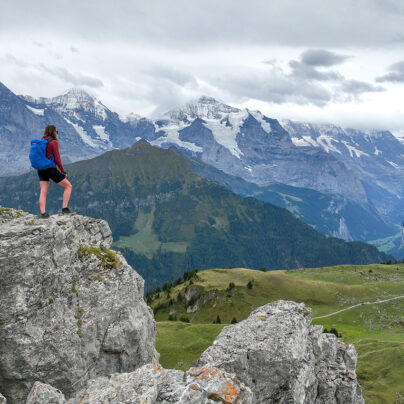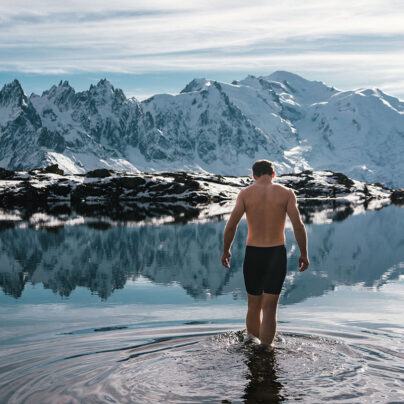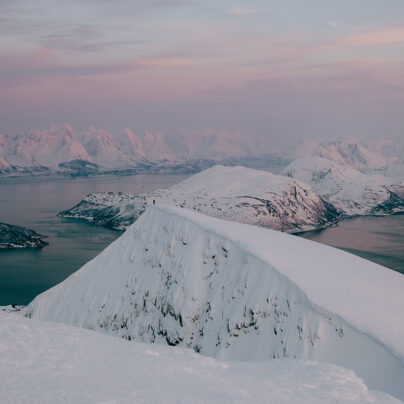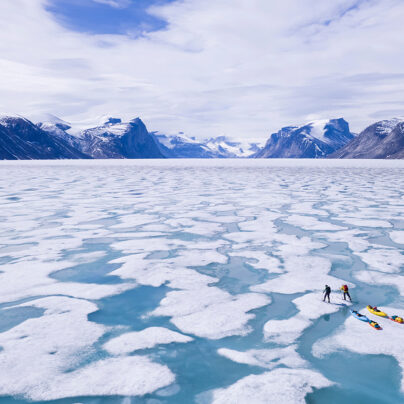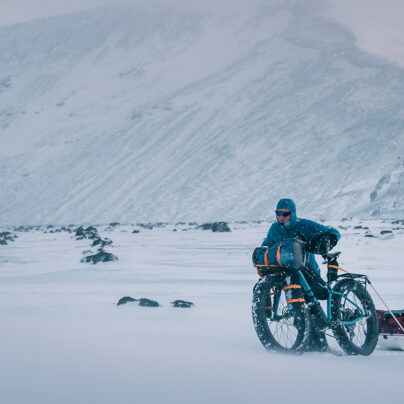Moment of Commitment
Freediver Anna von Boetticher explores a whale flenseplassen in Arctic Greenland
Written by Anna von Boetticher // Photography by Alex Dawson
In freediving, there is a moment when I must commit myself to the dive. I choose to introduce a break in the rhythm of breathing – a rhythm that is so natural to us. And, within that pause, I immerse myself in a multitude of water worlds with everything I have: mind, body, and spirit.
Sometimes this immersion is hard, and the unity we all seek with the environment around us eludes me. Other times, such as in this Arctic wilderness, there is magic in the transition from one realm to the other, intensified by the fact that I cannot see what lies beneath me in this frozen place. Not knowing what I am about to face requires a high level of care for my safety, as well as trust in my ability to cope with whatever I will encounter.
On our first day back in East Greenland, we woke to a morning that reminded us of what true Arctic cold feels like. As we made our way onto the frozen fjord near the small village of Tasiilaq, the wind cut through my three hats, donned in a hopeless attempt to keep my ears warm. The ice was covered by over a metre of snow, forcing us to shovel hard before cutting the hole that would be our door to the world below the surface. We worked for hours until, under a sky heavy with incoming weather, it was time to prepare myself to dive. Forcing the cold from my mind, I listened to nothing but the air flowing in and out of my lungs in a slow, controlled rhythm. Then, after a final, deep breath, I submerged my face and slid through the thick layer of slush that had already formed in the water.
As I dropped through the hole near the shore, my first sense was one of a vast, deepening darkness. Snow that had fallen in the last couple of weeks had compacted on top of the exceptionally thick ice, cutting the light. In weather like this we had to consider our choices with great care. Take it easy, I thought to myself, kicking softly towards the bottom. When my eyes adjusted to the gloom, a place so mysterious and strange was revealed to me that it was hard to comprehend. Enormous skeletons lay scattered in all directions: the bones of whales, hunted and killed by the local people.
In a highly regulated community effort, a few whales are caught each year – a strict quota from the area’s stable whale population. At least five boats with a two-man crew must be involved. When the hunters return, they bring the whale to shore, where the villagers join them to remove the meat and blubber. What is left of the animal gets pulled into the shallows by the tide. There the skeleton rests while any flesh left on the bones is eaten by the small creatures of the sea.
The flenseplassen – the area where the hunters bring their catch – was one of the most atmospheric places I have ever experienced underwater. Later, I was asked if seeing so much death was creepy or disgusting, but that’s not how it felt to me at all. What I saw in the light of my torch was the simple cycle of life on the shores of a small village in the Arctic.



One thing that any experience in nature will be sure to teach you is that plans rarely work out as you think they should. Just as we felt we understood the conditions and knew where and how we could explore, a storm rolled in, broke up all the ice in the fjord, and pushed it away to the open sea in a matter of hours. Reaching our locations on foot or by crossing the ice with Ski-Doos had become impossible. It was time to find a boat and an experienced captain to take us far out to edge of the bay – where currents had trapped large icebergs in a field of pack ice.
When my eyes adjusted to the gloom, a place so mysterious and strange was revealed to me that it was hard to comprehend. Enormous skeletons lay scattered in all directions: the bones of whales that had been hunted and killed by the local people.
Compared to the solid frozen surface we were used to in the fjord, this was a tricky area to work on. Ice floes of varying thickness were bunched up together, with thin ice in the gaps, ready to break away as you stepped on it. This was not a place to spend time cutting holes. In the end, we set out from the open water surrounding our boat, diving from opening to opening, looking for small holes in the ice – much like seals do – until we reached a glorious area between two large icebergs. This looked ideal for exploration.
I took some time to get my bearings before dropping down to truly take in the space. Hovering motionless a couple of metres beneath the surface, I was mesmerised by the subtle shades of the ice. Sunlight filtered down, bringing out the blue in a sheer, straight wall that extended next to me into the distance, like the side of a large building on a city street. Following its gentle curve, I swam down a frozen corridor between two icebergs and felt drawn to explore the caverns I could see carved into their bases. However, as I reached the other side, I mistook a circular shimmering spot for the hole I wanted to surface in, only to realise it was nothing but a large air bubble trapped beneath the ice. I had made the right choice in not exploring any caves. Diving like a seal from hole to hole is not as simple as it may seem and exploring a labyrinth of icebergs on a single breath is a tricky endeavour.


Each time we submerge ourselves into this world below, we find new elements that challenge our abilities. Each time we need to re-evaluate our approach, the way we work as a team, and the way in which we respond to these ever-changing environments. Yet each time we also discover something new, something unseen, and something that fills us with a sense of wonder. And so it is worth it: worth the wait, the money, the time, the effort. These moments are why we return over and over again.
This story was first published in Sidetracked Magazine Volume 25
Written by Anna von Boetticher // @freediveanna
Photography by Alex Dawson // @alex_dawson_photography




